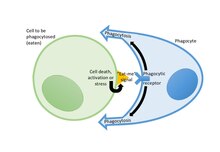
Eat-me signals are molecules exposed on the surface of a cell to induce phagocytes to phagocytose (eat) that cell. Currently known eat-me signals include: phosphatidylserine, oxidized phospholipids, sugar residues (such as galactose), deoxyribonucleic acid (DNA), calreticulin, annexin A1, histones and pentraxin-3 (PTX3).
The most well characterised eat-me signal is the phospholipid phosphatidylserine. Healthy cells do not expose phosphatidylserine on their surface, whereas dead, dying, infected, injured and some activated cells expose phosphatidylserine on their surface in order to induce phagocytes to phagocytose them. Most glycoproteins and glycolipids on the surface of our cells have short sugar chains that terminate in sialic acid residues, which inhibit phagocytosis, but removal of these residues reveals galactose residues (and subsequently N-acetylglucosamine and mannose residues) that can bind opsonins or directly activate phagocytic receptors. Calreticulin, annexin A1, histones, pentraxin-3 and DNA may be released by (and onto the surface of) dying cells to encourage phagocytes to eat these cells, thereby acting as self-opsonins. Eat-me signals, or the opsonins that bind them, are recognised by phagocytic receptors on phagocytes, inducing engulfment of the cell exposing the eat-me signal.
See also
References
- ^ Ravichandran, Kodi S. (2011). "Beginnings of a Good Apoptotic Meal: The Find-Me and Eat-Me Signaling Pathways". Immunity. 35 (4): 445–455. doi:10.1016/j.immuni.2011.09.004. PMC 3241945. PMID 22035837.
- ^ Park, Seung-Yoon; Kim, In-San (2017). "Engulfment signals and the phagocytic machinery for apoptotic cell clearance". Experimental & Molecular Medicine. 49 (5): e331. doi:10.1038/emm.2017.52. ISSN 1226-3613. PMC 5454446. PMID 28496201.
- ^ Nagata, Shigekazu; Segawa, Katsumori (2021). "Sensing and clearance of apoptotic cells". Current Opinion in Immunology. 68: 1–8. doi:10.1016/j.coi.2020.07.007. PMID 32853880. S2CID 221360052.
- ^ Cockram, Tom O. J.; Dundee, Jacob M.; Popescu, Alma S.; Brown, Guy C. (2021). "The Phagocytic Code Regulating Phagocytosis of Mammalian Cells". Frontiers in Immunology. 12: 629979. doi:10.3389/fimmu.2021.629979. ISSN 1664-3224. PMC 8220072. PMID 34177884.
- Kelley, Shannon M; Ravichandran, Kodi S (2021). "Putting the brakes on phagocytosis: "don't-eat-me" signaling in physiology and disease". EMBO Reports. 22 (6): e52564. doi:10.15252/embr.202152564. ISSN 1469-221X. PMC 8183410. PMID 34041845.